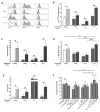IL-17 stimulates differentiation of human anti-inflammatory macrophages and phagocytosis of apoptotic neutrophils in response to IL-10 and glucocorticoids
- PMID: 23596310
- PMCID: PMC3677729
- DOI: 10.4049/jimmunol.1203017
IL-17 stimulates differentiation of human anti-inflammatory macrophages and phagocytosis of apoptotic neutrophils in response to IL-10 and glucocorticoids
Abstract
Exposure of human monocytes/macrophages to anti-inflammatory agents, such as IL-10 or glucocorticoids, can lead to two separate fates: either Fas/CD95-mediated apoptosis or differentiation into regulatory and efferocytic M2c (CD14(bright)CD16(+)CD163(+)Mer tyrosine kinase(+)) macrophages. We found that the prevalent effect depends on the type of Th cytokine environment and on the stage of monocyte-to-macrophage differentiation. In particular, the presence of IFN-γ (Th1 inflammation) or the prolonged exposure to IL-4 (chronic Th2 inflammation) promotes apoptosis of monocytes/macrophages and causes resistance to M2c differentiation, thus provoking impaired clearance of apoptotic neutrophils, uncontrolled accumulation of apoptotic cells, and persistent inflammation. In contrast, the presence of IL-17 (Th17 environment) prevents monocyte/macrophage apoptosis and elicits intense M2c differentiation, thus ensuring efficient clearance of apoptotic neutrophils and restoration of anti-inflammatory conditions. Additionally, the Th environment affects the expression of two distinct Mer tyrosine kinase isoforms: IL-4 downregulates the membrane isoform but induces an intracellular and Gas6-dependent isoform, whereas IFN-γ downregulates both and IL-17 upregulates both. Our data support an unexpected role for IL-17 in orchestrating resolution of innate inflammation, whereas IFN-γ and IL-4 emerge as major determinants of IL-10 and glucocorticoid resistance.
Figures






Similar articles
-
Efficient clearance of early apoptotic cells by human macrophages requires M2c polarization and MerTK induction.J Immunol. 2012 Oct 1;189(7):3508-20. doi: 10.4049/jimmunol.1200662. Epub 2012 Aug 31. J Immunol. 2012. PMID: 22942426 Free PMC article.
-
Antibody Cross-Linking of CD14 Activates MerTK and Promotes Human Macrophage Clearance of Apoptotic Neutrophils: the Dual Role of CD14 at the Crossroads Between M1 and M2c Polarization.Inflammation. 2018 Dec;41(6):2206-2221. doi: 10.1007/s10753-018-0864-x. Inflammation. 2018. PMID: 30091033
-
Glucocorticoids induce protein S-dependent phagocytosis of apoptotic neutrophils by human macrophages.J Immunol. 2009 Aug 1;183(3):2167-75. doi: 10.4049/jimmunol.0803503. Epub 2009 Jul 13. J Immunol. 2009. PMID: 19597001
-
More Than Suppression: Glucocorticoid Action on Monocytes and Macrophages.Front Immunol. 2019 Aug 27;10:2028. doi: 10.3389/fimmu.2019.02028. eCollection 2019. Front Immunol. 2019. PMID: 31507614 Free PMC article. Review.
-
Interferon-gamma: biologic functions and HCV terapy (type I/II) (2 of 2 parts).Clin Ter. 2006 Sep-Oct;157(5):457-68. Clin Ter. 2006. Retraction in: Clin Ter. 2008 May-Jun;159(3):208. PMID: 17147054 Retracted. Review.
Cited by
-
Clinical significance of macrophage phenotypes in cardiovascular disease.Clin Transl Med. 2014 Nov 21;3(1):63. doi: 10.1186/s40169-014-0042-1. eCollection 2014 Dec. Clin Transl Med. 2014. PMID: 25635207 Free PMC article.
-
Functional aspects, phenotypic heterogeneity, and tissue immune response of macrophages in infectious diseases.Infect Drug Resist. 2019 Aug 22;12:2589-2611. doi: 10.2147/IDR.S208576. eCollection 2019. Infect Drug Resist. 2019. PMID: 31686866 Free PMC article.
-
Tumor Associated Macrophages: Origin, Recruitment, Phenotypic Diversity, and Targeting.Front Oncol. 2021 Dec 20;11:788365. doi: 10.3389/fonc.2021.788365. eCollection 2021. Front Oncol. 2021. PMID: 34988021 Free PMC article. Review.
-
Head and neck squamous cell carcinoma cell lines have an immunomodulatory effect on macrophages independent of hypoxia and toll-like receptor 9.BMC Cancer. 2021 Sep 3;21(1):990. doi: 10.1186/s12885-021-08357-8. BMC Cancer. 2021. PMID: 34479492 Free PMC article.
-
Parallel Aspects of the Microenvironment in Cancer and Autoimmune Disease.Mediators Inflamm. 2016;2016:4375120. doi: 10.1155/2016/4375120. Epub 2016 Feb 22. Mediators Inflamm. 2016. PMID: 26997761 Free PMC article. Review.
References
-
- Estaquier J, Ameisen JC. A role for T-helper type-1 and type-2 cytokines in the regulation of human monocyte apoptosis. Blood. 1997;90:1618–1625. - PubMed
-
- Schmidt M, Lügering N, Pauels HG, Schulze-Osthoff K, Domschke W, Kucharzik T. IL-10 induces apoptosis in human monocytes involving the CD95 receptor/ligand pathway. Eur. J. Immunol. 2000;30:1769–1777. - PubMed
-
- Schmidt M, Lügering N, Lügering HG, Pauels HG, Schulze-Osthoff K, Domschke W, Kucharzik T. Role of the CD95/CD95 ligand system in glucocorticoid-induced monocyte apoptosis. J. Immunol. 2001;166:1344–1351. - PubMed
-
- Ottonello L, Bertolotto M, Montecucco F, Dapino P, Dallegri F. Dexamethasone-induced apoptosis of human monocytes exposed to immune complexes. Intervention of CD95- and XIAP-dependent pathways. Int. J. Immunopathol. Pharmacol. 2005;18:403–415. - PubMed
-
- Martinez FO, Sica A, Mantovani A, Locati M. Macrophage activation and polarization. Front. Biosci. 2008;13:453–461. - PubMed
Publication types
MeSH terms
Substances
Grants and funding
LinkOut - more resources
Full Text Sources
Other Literature Sources
Research Materials
Miscellaneous

